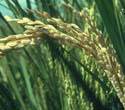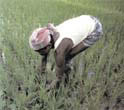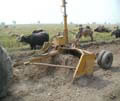Land Leveling
Introduction
Leveling rice fields improves water use efficiency, increases grain yield, and improves grain quality.
Leveling land improves water coverage which:
- Reduces the amount of water required for land preparation
- Improves crop establishment
- Decreases the time to complete tasks
- Results in better crop stands
- Reduces weed problems and
- Results in uniform crop maturity
Research Findings
 |
Crop Yield In Cambodia, land leveling has increased yiel by 24% or 530 kilograms per hectare. For every 10mm in surface variation, there was a yield loss of 260 kg of grain. |
 |
Weed Control Weeding time was reduced from 21 to 5 labor-days/ha. |
 |
Farm Operation Increases field sizes from 0.1 ha to 0.5 ha thus increasing the farming area by 5% to 7% Reshaping fields has also reduced operating times by 10% to 15%. |
 |
Seeding Practices
|
 |
Efficiency of Water Use An extra 100mm of water must be stored in the field to give complete water coverage. Water in the higher fields can be used in the lower fields for land preparation, plant establishment, and irrigation. |
Other Benefits
- Reduction in weeds.
- Reduction in farm operation time.
- Harvest evenly ripened crop, and
- Shed floodwaters more rapidly.
Systems of Land Leveling
Different systems require different field conditions and operating time.
 |
1. Draft animals and two-wheel tractors using harrows and leveling boards. These leveling techniques require total in field water coverage and require 7-8 days for a two-wheel tractor and 12 days per ha using draft animals |
 |
2. Four-wheel tractor using rear mounted tractor blades or drag buckets. In wet fields a rear-mounted tractor blade is best while in dry fields a hydraulically operated drag bucket is superior. Work rates depend on the tractor size and the amount of soil to be moved. It will take approximately eight hours to level 1 ha with a rear mounted tractor blade. This is reduced to about four hours when using a drag bucket. |
 |
3. Four-wheel tractor with a laser controlled bucket. The use of laser controlled equipment results in a much more level field. Accuracy was improved by 50% and the time required was halved. |
Cost of Land Leveling
The costs vary according to the topography, the shape of the field, and the equipment used.
Cost ranges from $3 to $5 per 10 mm of soil moved/ha.
More fertilizer, especially phosphate, is necessary in areas from which soil is moved.
Re-leveling the whole field should not be necessary for at least eight to ten years.
Financial Benefits of Land Leveling
A cash flow analysis shows that financial benefits do result from land leveling. Costs will normally be recouped by the second crop after leveling.







